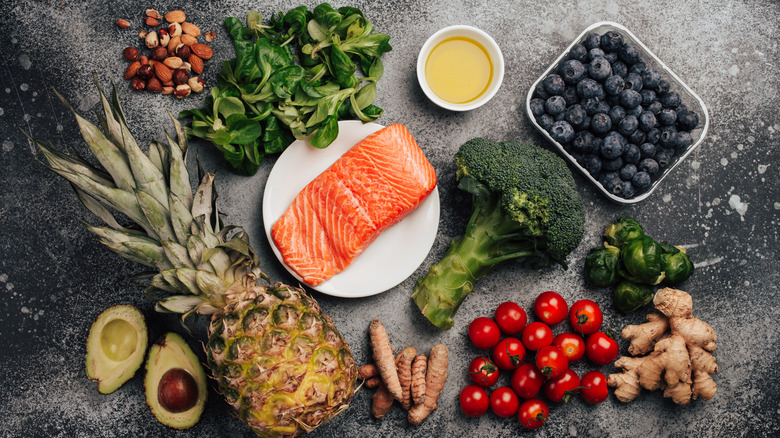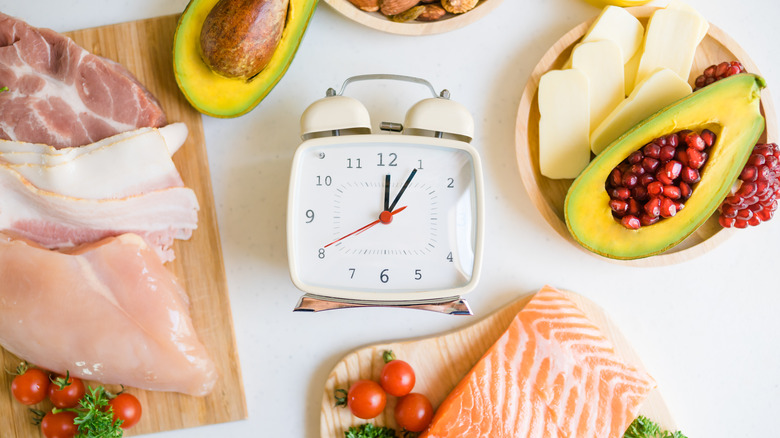What Is The Galveston Diet And How Does It Work?
We may receive a commission on purchases made from links.
There is a general vacuum in the area of nutritional and weight loss advice for women going through menopause despite it being a particularly challenging time (via Byrdie). Menopause brings with it hot flashes, slowed metabolism, weight gain, inflammation, and mood changes, and these can be a source of distress for most women.
The Galveston diet is a program designed especially for such women. Put together by OBGYN physician Mary Claire Haver, the diet focuses on harnessing the benefits of consuming anti-inflammatory foods and intermittent fasting to combat the symptoms of menopause. When the age-old advice to eat less and exercise more stopped working for lots of women going through life changes like aging and menopause (including Haver herself), Haver decided to research into how weight loss could be effectively achieved at this age, per Eating Well. Soon after, the Galveston diet was born. She's even published a book on the program titled "The Galveston Diet: The Doctor-Developed, Patient-Proven Plan to Burn Fat and Tame Your Hormonal Symptoms."
It might just be one of the healthy ways to lose weight for women over 50. So, what exactly is the Galveston diet and how does it work? What are the foods you can eat and what should you be avoiding?
What can you eat on a Galveston diet?
The Galveston diet is more than about just what foods you should be consuming for optimal weight loss; it is also about when you should be eating them. The focus is on consuming anti-inflammatory foods like fresh fruits and vegetables, lean proteins like fish or chicken, whole grains (brown rice and oatmeal), healthy fats (salmon, olive oil, and nuts), and full-fat dairy, per Eating Well. What you will be cutting out of your diet are refined sugars, most processed foods, fried foods, foods with artificial flavoring and color in them, high fructose products, plus oils considered to be inflammatory like vegetable oil and canola oil.
As for when you should be consuming these foods, The Galveston diet follows an intermittent fasting routine daily, per Hum Nutrition. Eating is restricted to an 8-hour window and you fast for the remaining 16 hours of the day.
While you're fasting, you can consume beverages like water and unsweetened coffee/tea but no calorie-filled foods or drinks are permitted, reports Healthline.
How does the Galveston diet work?
The Galveston diet mainly works by promoting the consumption of healthy foods like whole grains, leafy green vegetables and fruits, and healthy fats. The diet also sets itself up for success because of how sustainable it is in the long run. The focus is not so much on eating less as it is on eating more of the good stuff. Lots of processed meats like bacon and sausages, as well as sugary drinks, refined grains like white bread and pasta, and fried foods encourage inflammation in the body (via Houston Methodist). Cutting those out can be extremely beneficial to overall health.
Uma Naidoo, a nutritional psychiatrist and author of the book "This is Your Brain on Food," tells Byrdie that eating foods that improve inflammation markers in our bodies also affects our gut, which in turn affects mood. As we get older, our bodies struggle to digest food properly because of changes in insulin sensitivity and a slower metabolism. The healthy diet advocated by the Galveston program helps stabilize insulin levels too.
The concept of intermittent fasting is by no means a new one. "From what we know of the current research, having an 8-hour window of eating followed by a 16-hour period of fasting might support weight control and improve insulin sensitivity," says Naidoo. Intermittent fasting promotes the consumption of fewer calories, which further promotes weight loss. It is also linked to reduced blood pressure, per Healthline.
The Galveston Diet might just be one of the healthy ways to lose weight without dieting. Talk to your doctor if you think it might be right for you.


